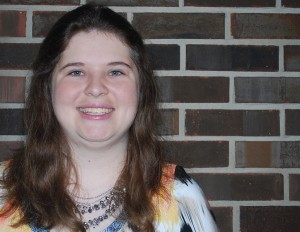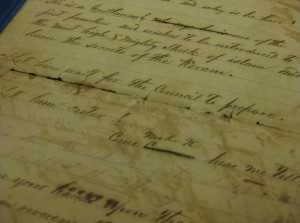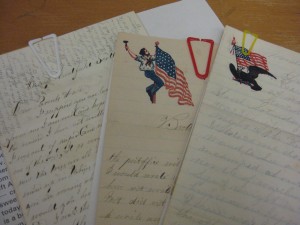Editor’s Note: This interview will be posted in two parts. Check back on Wednesday for the second portion of my conversation with Haley.
First off, what got you interested in special collections?
My love of special collections stems from my first two encounters with archivists. As a high school junior, I visited the Alabama Department of Archives and History in Montgomery on a trip sponsored by the Cullman County Youth Leadership initiative. The archivists that led the tour were incredibly gracious, taking the time to show us some of their favorite collections and explain their preservation efforts. That trip was my first introduction to the archival profession, and I was fascinated by my first “behind the scenes” look at archives.
In the summer between my junior and senior year, I attended Alabama Governor’s School, a two-week program held at Samford University each summer. At governor’s school, I took a class in Alabama history and had the chance to research and write a paper using materials housed in Samford’s Department of Special Collection. Even though I was a young researcher, archivist Elizabeth Wells went above and beyond to make sure I found the materials I needed to complete the paper. Ms. Wells’ enthusiasm for special collections was irresistible; using census records, letters, and maps, she told fascinating stories about Birmingham’s history.
I was blessed with the opportunity to attend Samford and double major in journalism and history. Ms. Wells’ door was always open if I ever had a question about the resources available at Samford; her advice was invaluable. During my senior year at Samford, I had the opportunity to work as a student research assistant at the Department of Special Collection, answering patron’s research requests. Working with Ms. Wells and the rest of the Special Collection staff taught me a number of valuable skills, including perseverance, accuracy, and attention to detail.
What roles have you had at The University of Alabama?
I have had the opportunity to work on several different archival projects during my time at the University of Alabama. In February, I started work as a student employee at the A. S. Williams III Americana Collection. I have been responsible for processing manuscripts, the unique and unpublished letters, diaries, book manuscripts, and business records collected by Mr. Williams, who generously donated his collection to the University of Alabama in 2010. I have arranged and described a diverse set of materials, ranging from Civil War soldiers’ letters to the business records of Birmingham steel companies. As of November 12, 2013, finding aids for 59 collections are now available online, and more finding aids will be available soon. I’m very excited that these collections are now open to researchers, and I am grateful for the opportunity to play a small role in making this rich collection accessible.
In August, I was appointed to a one-semester term working as a graduate assistant for the Department of Special Collections. I have split my time as an assistant between the Williams Collection and the W. S. Hoole Special Collections library. At Hoole, I worked with another graduate assistant and began compiling a comprehensive inventory of manuscripts held at the library.
Finally, I have worked at a third on-campus archival collection not affiliated with the university library Department of Special Collections. The Center for the Study of Tobacco and Society is a collection compiled by Dr. Alan Blum. The materials collected by Dr. Blum address how advertising and business efforts by the tobacco industry have impacted American culture and public health initiatives. Since March, I have been arranging, describing, and digitizing materials related to alcohol marketing and addiction; this collection is a small subset related to the larger collection on the tobacco industry. I have also briefly worked with the larger collection of tobacco materials, helping create a detailed inventory of items for an exhibit created by Dr. Blum. [Editor’s Note: Visit the Center for the Study of Tobacco and Society’s exhibition up in the Pearce Lobby of the Gorgas Library now through November 20, 2013.]
Gaining archival experience as a student employee has greatly enriched my experience at the University of Alabama. I have enjoyed working with and learning from the talented staff at the Department of Special Collections, and I appreciate the training opportunities that the department has provided. I have learned a great deal about processing, exhibit planning, and reference by working as a student in these university archives.
What is the most surprising item you’ve seen during your time in the stacks?
I was particularly surprised to come across a handwritten initiation script for the Cowbellion de Rakin Society (W.0035), Mobile’s earliest carnival society and one of the earliest Mardi Gras societies in the nation. The Cowbellion de Rakin society set the foundation for the parades and revelry that have become a hallmark of Mardi Gras celebrations; however, the society’s first parade, led by revelers carrying cowbells and rakes, was actually held on New Year’s Eve in 1830. Gradually, floats and the tradition of throwing items to the crowd were introduced. In 1888, the New Year’s Eve parade was discontinued, but the parade tradition lives on in the elaborate Mardi Gras celebrations held in Mobile and New Orleans.
Out of all the items you’ve come across, which is your favorite?
That’s a really tough question! The Williams Collection contains such a variety of fascinating materials it’s almost impossible to choose just one item. I would encourage researchers to visit the Williams Collection and discover their own favorites.
If I had to pick a single item, I would have to pinpoint a letter written by Union soldier Morris Boss (W.0078). Boss enlisted in November 1861, and he saw his share of death and suffering. Many of his letters describe the hardships of military life and he discusses a number of historically significant issues, including the draft and the execution of soldiers who deserted.
However, my favorite letter deals with none of these issues. Boss writes a letter home in 1865 after the war has ended and he is preparing to return home. Sitting at the Union camp, he talks about a kitten he plans to adopt and take home. The end of the letter is smudged and splotched. In a postscript, Boss offered an explanation for the messy writing – the kitten, which had been standing on the table playing with a pen, had walked across the letter!
This letter may not have the same historical significance as Boss’ other letters, but I think it still tells a compelling story. Boss lived through a horrific war, but he was still able to show compassion to a kitten that needed a home. The innocence of Boss’ letter surprised and delighted me.
There are several reasons that this little letter is one of my favorite items in the Williams Collection. I love archival materials that provide a new perspective about events. I also love when items provide insight into humanity. The Williams Collection, like most archives, contains stories of love and loss, triumph and tragedy – all of the experiences that define the human experience, regardless of time or place.
Come back on Wednesday to read more about Haley’s time in the Division of Special Collections at The University of Alabama and her upcoming plans after she graduates this December from the School of Library and Information Studies!





2 Responses to Part 1: Interview with Haley Aaron, Division of Special Collections graduate assistant